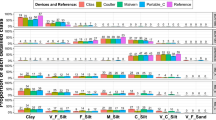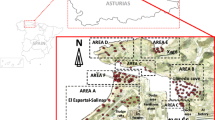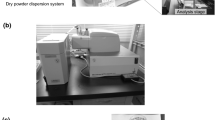Abstract
The aim of this study was to use a new approach to investigate aeolian particle granulometry and micromorphology. Taking total aeolian deposition into account, we used parameters such as, particle area, perimeter, shape analysis for particle roughness (area/perimeter) and elongation (long/short axis). These parameters were analyzed on temporal and spatial scales at four study sites in the eastern Negev Desert, Israel. The total collection of particles was sorted into three size groups based on particle area to facilitate comparison. The classic definition of particle size (equating particle length with particle diameter) produced relatively small variations among the three size classes (25–38.6%). Our proposed comprehensive method demonstrated significant variation among the three size classes (13.9–60.8%), e.g. the classic method placed 36.4% of the particles in size class two while the new method placed 60.8% of the particles in this size class; the differences were even more significant regarding size class 3 (38.6% vs. 13.9%, respectively). The classic method did not facilitate investigation of particle roughness and elongation. With this new approach, it was possible to clearly define the particles by size class, based on these characteristics. With roughness, the variation among size classes 2 and 3 was about 27%. With elongation, the variation among size classes two and three was about 21%. Applying similar investigation method to study the aeolian particle granulometry and micromorphology can better facilitate more detailed calculation of particle size distribution, roughness and elongation.
Similar content being viewed by others
References
Alshibli, K. A., Asce, M., Alsaleh, M. I., & Asce, A. M. (2004). Characterizing surface roughness and shape of sands using digital microscopy. Journal of Computing in Civil Engineering, 18, 36–45. doi:10.1061/(ASCE)0887-3801(2004)18:1(36)
Dregne, H. E. (1986). Desertification of arid lands. In F. El-Baz, & M. H. A. Hassan (Eds.), Physics of desertification. Dordrecht: Martinus, Nijhoff.
Esser, U. (1989). Zum Stickstoff – Haushalt arider Hangokosysteme im nordlichen Negev – Hochland, Israel und den Auswirkungen der Hang – Minicatchment – Technologie auf Stickstoffumsatze und – vorrate. Dissertation, Institute of Geography, Munster, Germany.
Gerson, R., Amit, R., & Grossman, S. (1985). Dust availability in desert terrains. A study in the deserts of Israel and the Sinai (pp. 220). Jerusalem: Institute of Earth Sciences, The Hebrew University of Jerusalem.
Goossens, D., & Offer, Z. Y. (1994). An evaluation of the efficiency of some aeolian dust collectors. Soil Technology, 7, 25–35. doi:10.1016/0933-3630(94)90004-3.
Goossens, D., & Offer, Z. Y. (1995). Comparisons of day-time and night-time dust accumulation in a desert region. Journal of Arid Environments, 31, 253–281. doi:10.1016/S0140-1963(05)80032-1.
Goudie, A. S., & Middleton, N. J. (1992). The changing frequency of dust storms through time. Climatic Change, 20, 197–225. doi:10.1007/BF00139839.
Griffin, D., & Kellogg, C. (2004). Dust storms and their impact on ocean and human health: Dust in earth’s atmosphere. EcoHealth, 1, 284–295. doi:10.1007/s10393-004-0120-8.
Offer, Z. Y., & Goossens, D. (2001a). Ten years of aeolian dust dynamics in a desert region (Negev desert, Israel): Analysis of airborne dust concentration, dust accumulation and the high-magnitude dust events. Journal of Arid Environments, 47, 211–249. doi:10.1006/jare.2000.0706.
Offer, Z. Y., & Goossens, D. (2001b). Airborne particle accumulation and composition at different locations in the northern Negev Desert. Annals of Geomorphology, 45, 101–120.
Pewe, T. L. (1981). An overview. In T. L. Pewe (Ed.), Desert dust: Origin, characteristics, and effect on man (pp. 1–10). Boulder: Geological Society of America Series (Special paper Geological Society of America Series 186, pp. 303).
Rheis, M. C., & Kihl, R. (1995). Dust deposition in southern Nevada and California, 1984–1989: Relations to climate, source area, and source lithology. Journal of Geophysical Research, 100, 8893–8918. doi:10.1029/94JD03245.
Sokal, R. R., & Rohlf, F. J. (1995). Biometry (3rd edn.). San Francisco: W. H. Freeman, & Company (pp. 859).
UNEP (1991). Status of desertification and implementation of the United Nations Plan of Action to Combat Desertification (pp. 77). Nairobi: UNEP.
Vanderstraeten, P., Lénelle, Y., Meurrens, P., Carati, D., Brenig, L., & Offer, Z. Y. (2006). Airborne particle granulometry and micromorphology during working and non working days in the Brussels environment. Transactions on Ecology and the Environment, 86, 287–295.
Vanderstraeten, P., Lénelle, Y., Meurrens, A., Carati, D., Brenig, L., Offer, Z. Y., et al. (2008). Micromorphology and chemistry of airborne particles in Brussels during agriculture working periods in surrounding region. Environmental Monitoring and Assessment. doi:10 1007/s 10661-007-0057-9.
Author information
Authors and Affiliations
Corresponding author
Rights and permissions
About this article
Cite this article
Zaady, E., Dody, A., Weiner, D. et al. A comprehensive method for aeolian particle granulometry and micromorphology analyses. Environ Monit Assess 155, 169–175 (2009). https://doi.org/10.1007/s10661-008-0426-z
Received:
Accepted:
Published:
Issue Date:
DOI: https://doi.org/10.1007/s10661-008-0426-z




